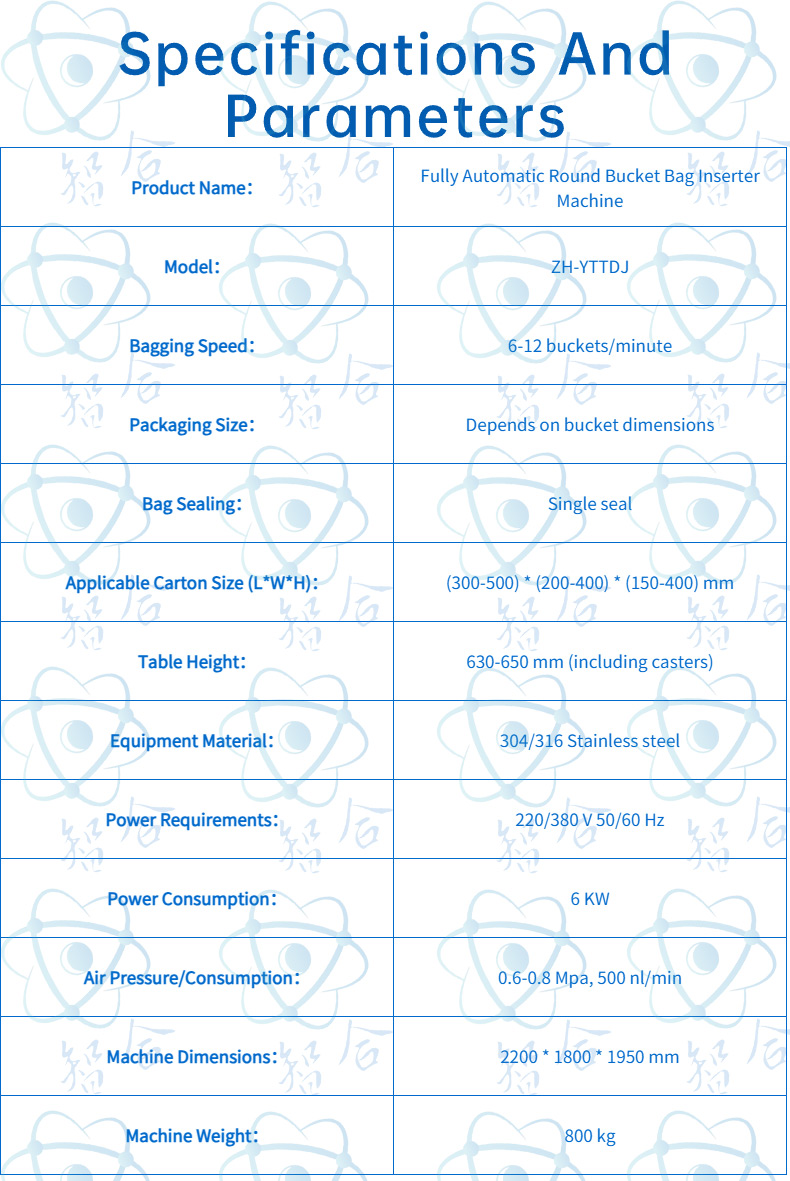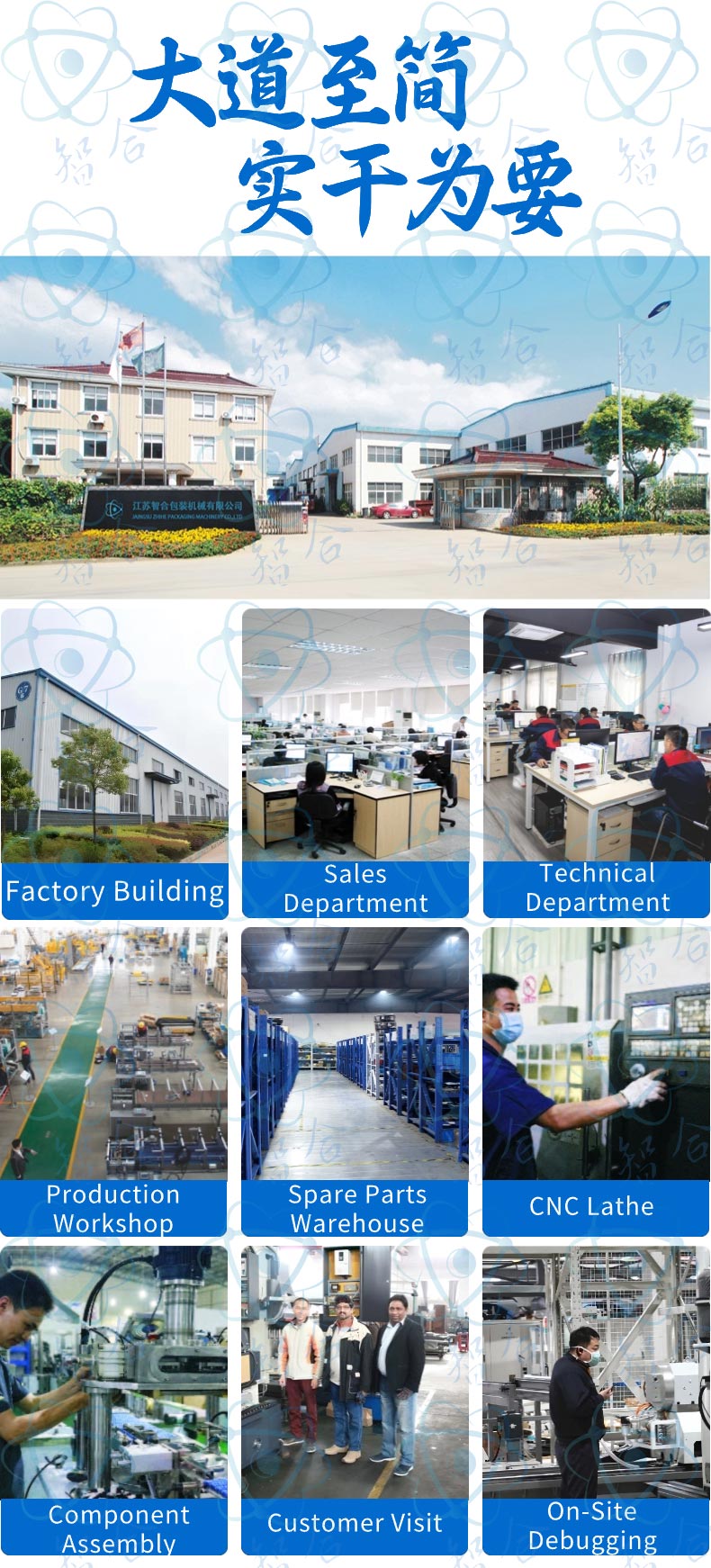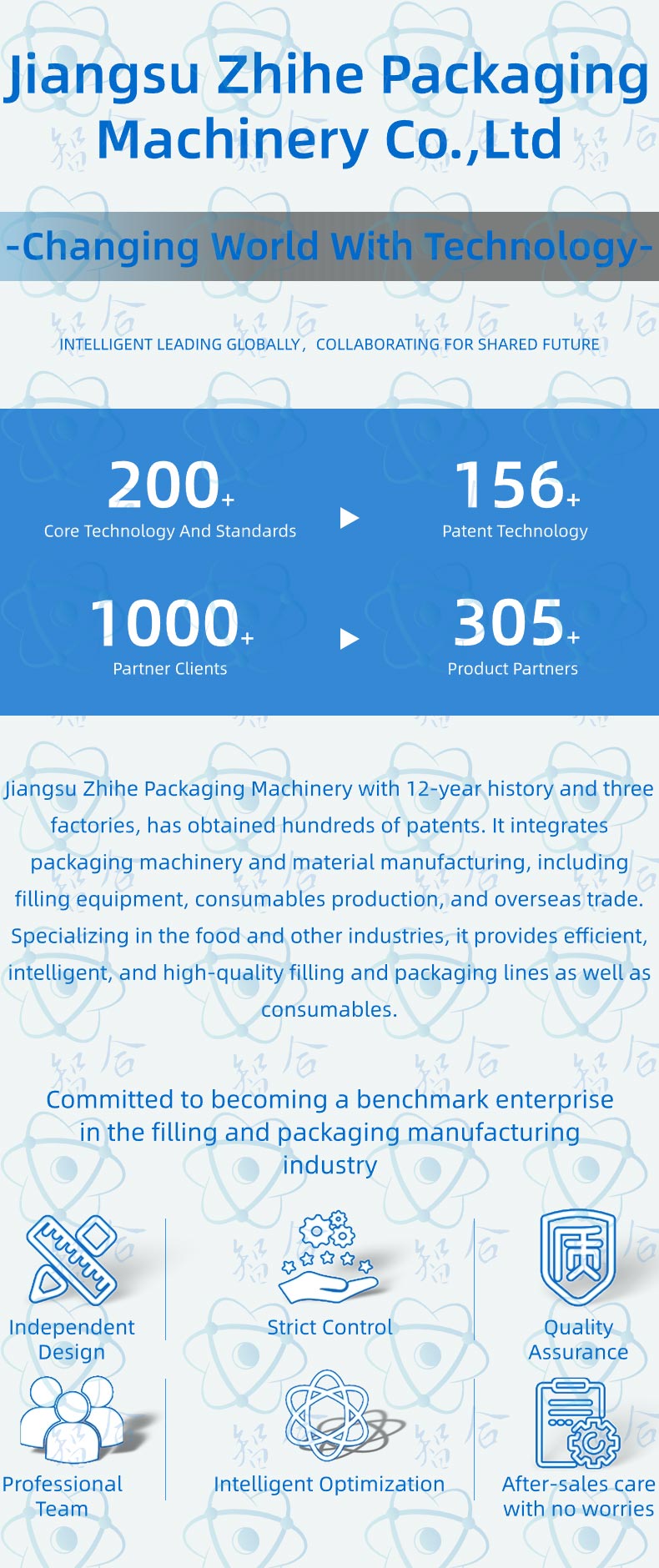

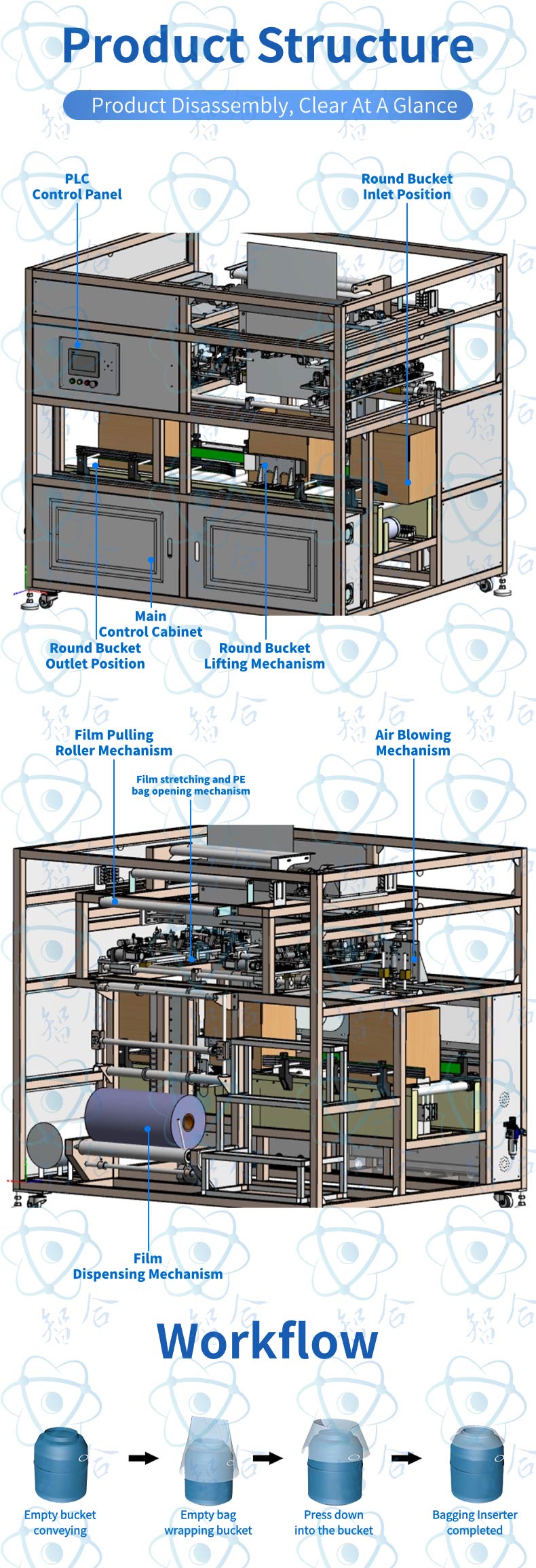
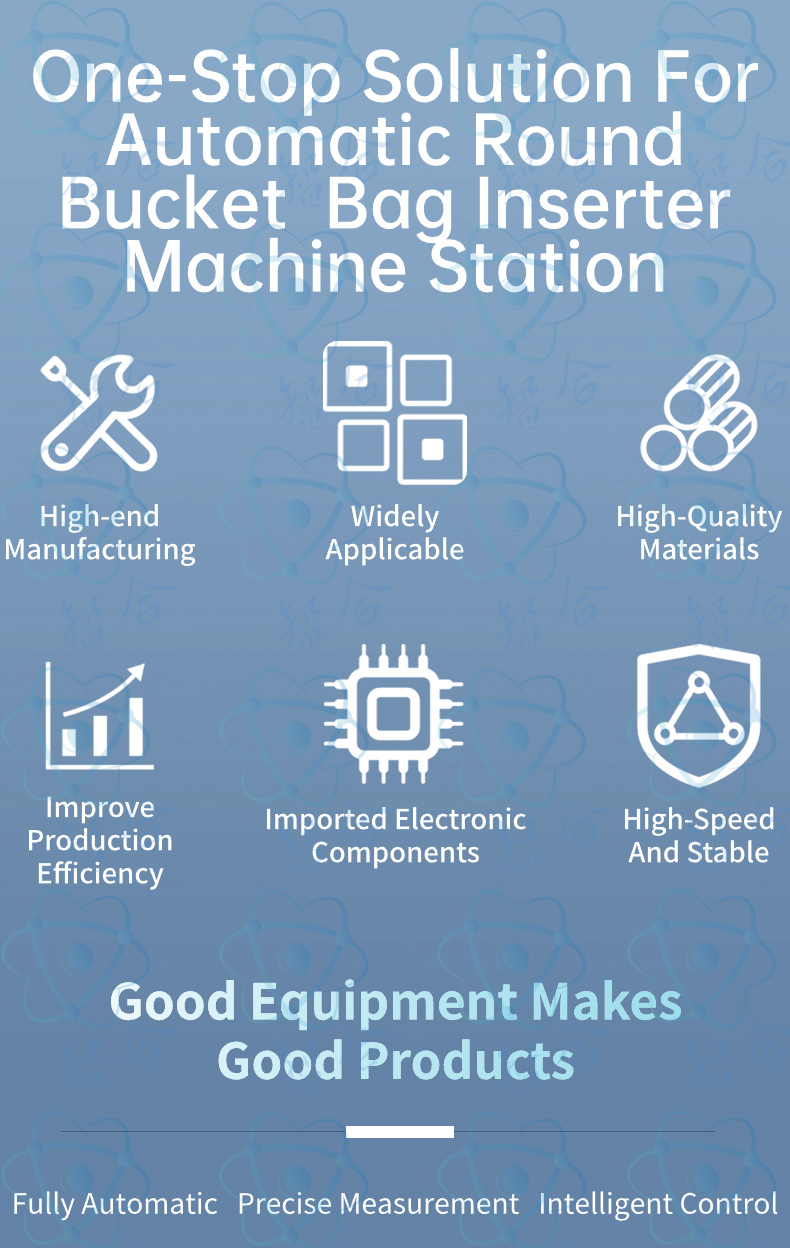
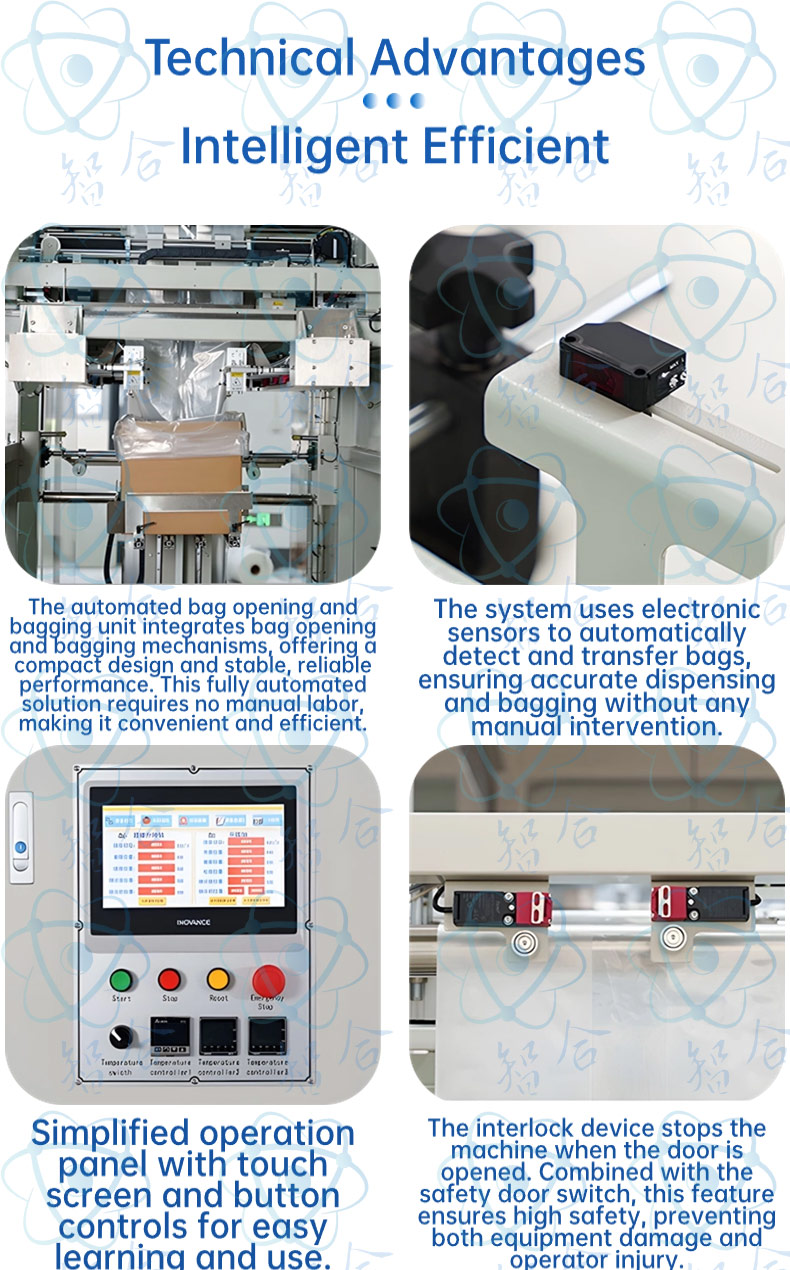
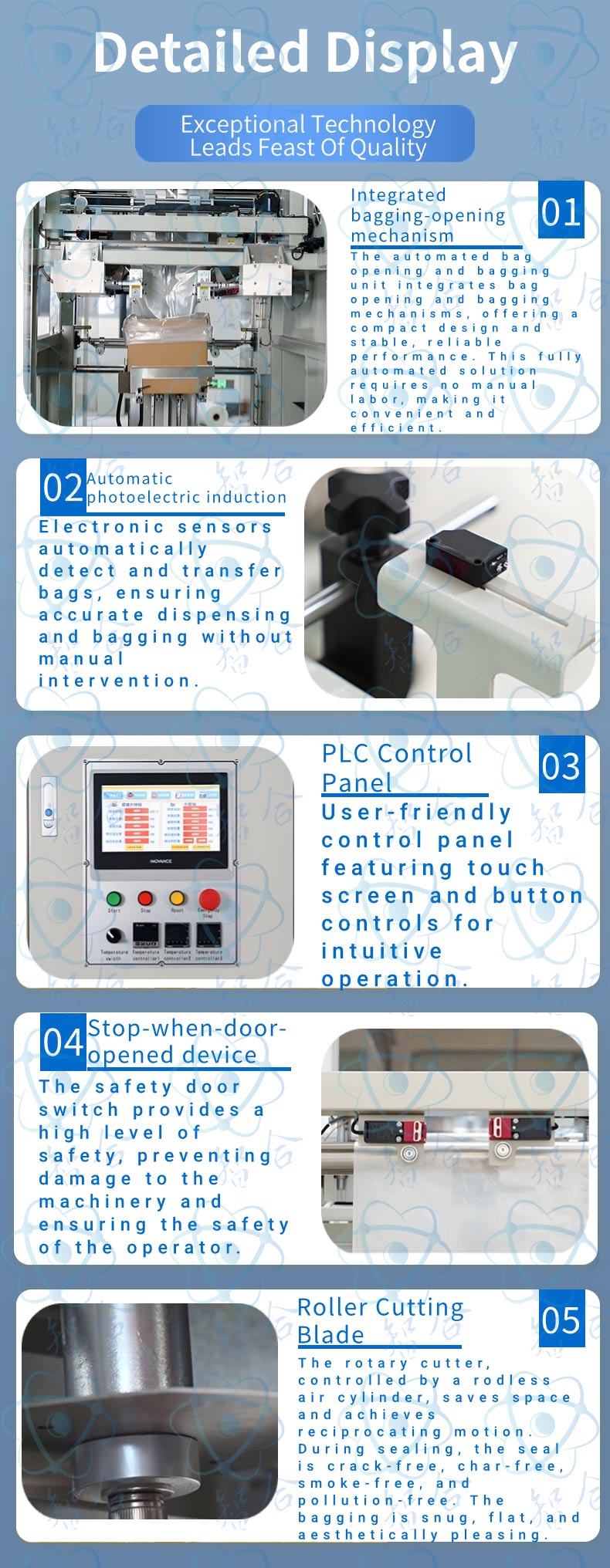
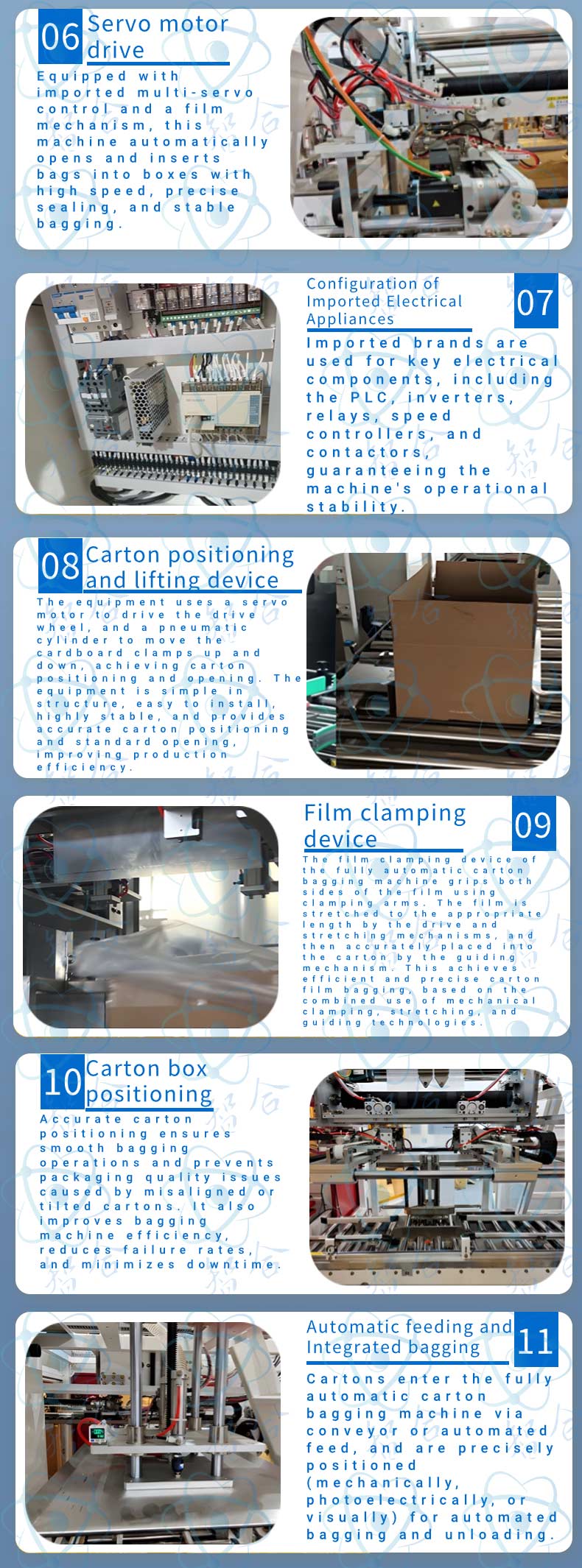
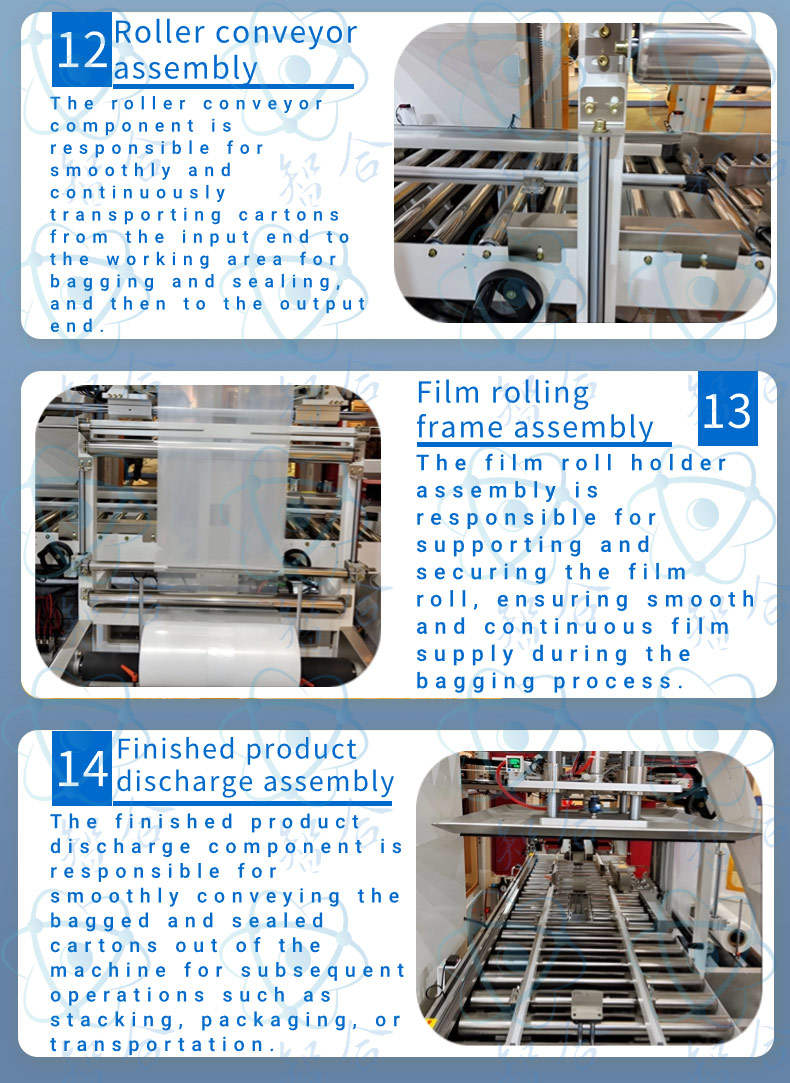 Technical Description of the Fully Automatic Round Bucket Bag Inserter Machine
Technical Description of the Fully Automatic Round Bucket Bag Inserter Machine
The fully Automatic Round Bucket Bag Inserter Machine plays a crucial role in modern automated packaging production lines, efficiently and accurately completing the automatic bag retrieval and opening, preparing for the subsequent material filling process. Below, I will provide a detailed technical description from multiple aspects including design principles, component mechanisms, workflow, and technical features.
I. Design Principles
The core design principle of the fully Automatic Round Bucket Bag Inserter Machine revolves around “round bucket rotation and mechanical coordination” to achieve automatic bag suction, unfolding, and bagging actions. Its main design concepts can be summarized as follows:
Continuity and Efficiency: Utilizing a round bucket rotation mechanism enables continuous bagging operations without interruption, significantly improving bagging efficiency and meeting the demands of large-scale production.
Precise Positioning and Reliability: Through precise mechanical structures and control systems, ensuring that each bag is accurately sucked, unfolded, and placed in the designated position, guaranteeing the accuracy and stability of the bagging process.
Flexible Adaptability: The design considers bags of different sizes, materials, and types, and through adjustable mechanisms and parameter settings, the equipment can adapt to various bag bagging requirements, enhancing the versatility of the equipment.
Automation and Intelligence: Integrating sensors, PLC control systems, etc., to achieve fully automated operation, reducing manual intervention, and providing intelligent functions such as fault self-checking and alarms, improving the automation level of the production line.
II. Component Mechanisms
The fully Automatic Round Bucket Bag Inserter Machine typically consists of the following main mechanisms, which work together to complete the entire bagging process:
Bag Magazine Mechanism:
Function: Used to store the stacks of bags to be bagged. Usually adopts a vertical or inclined structure to facilitate bag stacking and retrieval.
Composition: Mainly includes a hopper support, guide plates, bag pressing devices, etc. The bag pressing device usually adopts a cylinder or spring mechanism to ensure the stability and orderliness of the bag stack, preventing bags from scattering or tipping.
Bag Retrieval Mechanism:
Function: Separates and sucks bags one by one from the bag magazine. This is one of the core mechanisms of the bagging machine, and its performance directly affects the success rate and efficiency of bagging.
Types: Common bag retrieval mechanisms include vacuum suction cup type and mechanical gripper type.
Vacuum Suction Cup Type: Uses a vacuum generator to produce negative pressure, adsorbs the bag surface through suction cups, and then moves the suction cups to separate the bag from the bag stack. This method is suitable for bags with smooth surfaces and good air tightness, such as plastic bags and composite bags.
Mechanical Gripper Type: Uses mechanical grippers to grip the edges or specific parts of the bag, and then separates the bag from the bag stack. This method is more adaptable to various bag materials, including paper bags and woven bags.
Composition: Includes vacuum suction cups (or mechanical grippers), vacuum generators (or cylinder drive mechanisms), moving mechanisms (cylinders), sensors (detecting whether the bag has been successfully retrieved), etc.
Bag Unfolding Mechanism:
Function: Unfolds the bag mouth of the retrieved bag to facilitate smooth material filling.
Types: Common bag unfolding mechanisms include air blowing type, mechanical opening type, and vacuum-assisted type.
Air Blowing Type: Blows compressed air into the bag mouth through air nozzles, using air pressure to open the bag mouth. This method is simple and fast, suitable for bags that are relatively easy to unfold, such as plastic bags.
Mechanical Opening Type: Uses mechanical fingers or struts to insert into the bag mouth, using mechanical movement to open the bag mouth. This method has a larger unfolding force and is suitable for thicker or difficult-to-unfold bags.
Vacuum Assisted type: Combines vacuum suction cups to adsorb the inside of the bag opening, on top of the mechanical opening method, to improve the opening effect.
Composition: Includes air nozzles (or mechanical struts/fingers), air source (or drive motor), control valves, sensors (detecting whether the bag mouth has been successfully unfolded), etc.
Round Bucket Rotation Bagging Mechanism:
Function: The core mechanism, placing the bag with the unfolded mouth onto the designated round bucket or mold. Round bucket rotation is the key to achieving continuous bagging.
Composition: Mainly includes a rotating round bucket (with bag positioning and fixing structures on the surface), drive mechanism (servo motor driven), positioning mechanism (sensors and mechanical limits), bag clamping device (cylinders or mechanical clamps), etc.
Working Principle: The round bucket rotates under the drive of the drive mechanism. When it rotates to a specific position, the bag retrieval mechanism sends the unfolded bag to the top of the round bucket. The bag is guided by the positioning structure on the surface of the round bucket and accurately placed on the round bucket. The bag clamping device acts after the bag is in place, firmly clamping the bag on the round bucket, preventing the bag from falling off or shifting in subsequent processes.
Conveying Mechanism:
Function: Conveys the bagged round buckets to subsequent workstations, such as filling workstations and sealing workstations. Also responsible for outputting the filled and sealed bags.
Types: Common conveying mechanisms include chain type, belt type, and roller type.
Composition: Conveying chains/belts/rollers, drive motors, guide rails, support frames, etc. The conveying speed and rhythm need to match the speed of the entire production line.
Control System:
Function: Controls the coordinated operation of each mechanism of the entire bagging machine to achieve automated bagging. Also responsible for monitoring the equipment’s operating status, handling abnormal situations, and providing a human-machine interface.
Composition: PLC (programmable logic controller), touch screen (human-machine interface), sensors (photoelectric sensors, proximity sensors, pressure sensors, etc.), servo drives, frequency converters, pneumatic components (solenoid valves, cylinders, air pipes, etc.), safety protection devices, etc.
Frame and Protective Cover:
Function: Supports and fixes each mechanism, providing the overall frame structure of the equipment. The protective cover is used to protect the safety of operators and prevent accidental contact with moving parts.
Composition: Profile welded or bolted metal frame, metal or transparent plastic protective cover, safety doors, emergency stop buttons, etc.
III. Workflow
The workflow of the fully Automatic Round Bucket Bag Inserter Machine is usually as follows:
Bag Magazine Loading: Operators load the stacked bags into the bag magazine mechanism.
Equipment Startup: Start the control system, and the equipment enters the automatic operation state.
Bag Retrieval and Separation: The bag retrieval mechanism sucks or grips bags one by one from the bag magazine and separates them from the bag stack.
Bag Unfolding: The bag unfolding mechanism unfolds the bag mouth of the retrieved bag.
Round Bucket Rotation Bagging: The round bucket rotation mechanism rotates to the designated position, and the bag with the unfolded mouth is placed on the round bucket and fixed by the clamping device.
Conveying to the Next Workstation: The bagged round bucket is sent to the next workstation (such as the filling workstation) by the conveying mechanism.
Subsequent Processes: Perform material filling, sealing, and other operations at subsequent workstations (this part is not a function of the bagging machine itself, but needs to cooperate with the bagging machine).
Finished Product Output: The finished bags after filling and sealing are output by the conveying mechanism.
Equipment Monitoring and Maintenance: The control system monitors the equipment’s operating status in real time, and operators perform daily maintenance.
IV. Technical Features and Advantages
Compared with traditional manual bagging or semi-automatic bagging equipment, the fully Automatic Round Bucket Bag Inserter Machine has significant technical features and advantages:
High Degree of Automation: Achieves a series of actions such as automatic bag suction, unfolding, and bagging, without any manual intervention throughout the process, greatly improving production efficiency and reducing labor costs.
Fast Bagging Speed: The continuous bagging method of the round bucket rotation mechanism makes the bagging speed faster, which can meet the needs of high-speed production lines. The bagging speed can usually reach dozens or even hundreds of bags per minute.
High Bagging Accuracy: Precise mechanical structures and control systems ensure that each bag is accurately placed in the designated position, with good consistency in the bagging position, improving the quality and aesthetics of product packaging.
Strong Adaptability: By adjusting mechanism parameters, it can adapt to bags of different sizes, materials, and types, with good versatility, and can be applied to packaging needs in various industries.
Simple and Convenient Operation: Adopts a touch screen human-machine interface, and the operation parameter settings are simple and intuitive, easy to get started. It also has fault alarm and prompt functions, which is convenient for operators to maintain and troubleshoot.
Stable and reliable operation: Using high quality parts and precise assembly techniques, the equipment runs stably and reliably, with a low failure rate, and can run continuously and stably for long periods of time.
Reduced Human contact: Full automatic operation reduces the direct human contact with packaging materials, reducing the risk of secondary polution, and increases the products sanitary safety level. This is extremely advantageous in the food and medicine industries.
Strong Integrability:Easy to seamlessly integrate with upstream processes (such as bag making machines, labeling machines) and downstream processes (such as filling machines, sealing machines, packing machines) to form a complete automated packaging production line.
V. Application Fields:
The fully automatic round bucket bagging machine is widely used in automated packaging production lines for powder, granular, and lumpy materials in various industries such as food, chemical, pharmaceutical, feed, building materials, hardware, and electronics, for example:
Food Industry: Flour, rice, sugar, salt, milk powder, coffee, seasonings, puffed food, snack food, etc.
Chemical Industry: Fertilizers, pesticides, plastic granules, rubber granules, chemical raw materials, additives, etc.
Pharmaceutical Industry: Traditional Chinese medicine decoction pieces, Western medicine granules, medicinal powder, health products, etc.
Feed Industry: Livestock and poultry feed, aquatic feed, pet food, etc.
Building Materials Industry: Cement, mortar, putty powder, gypsum powder, tile adhesive, waterproof materials, etc.
Hardware and Electronics Industry: Screws, nuts, electronic components, small hardware parts, etc.